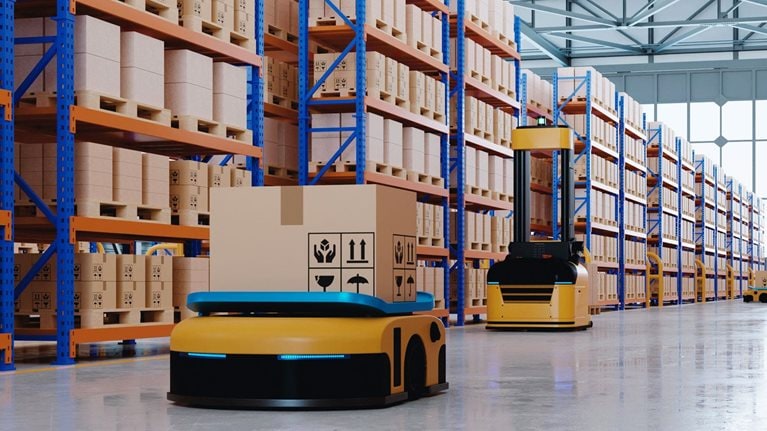As with most other industries, the COVID-19 pandemic has transformed global logistics in profound ways. But unlike most other industries, the decline in economic activity during the pandemic has not affected global logistics too negatively. The consumption of goods—and thus the corresponding logistics needs—has been left relatively unaffected.
This article reports that while the COVID-19 pandemic has accelerated the growth of global logistics, it has also widened the gap between the sector’s leaders and laggards. The market is becoming more dynamic, with many new start-ups providing increasingly intense competition. In response, legacy players are acting to consolidate strength with M&A activity or scale up operations by going public. This is especially true of the Asia market, where all indicators point to the continent’s recovery outpacing the rest of the world’s in the next year. The continent is expected to account for 57 percent of the growth of the global e-commerce logistics market between 2020 and 2025.
This may make Asia the single-most-important region for global trade and logistics activities going forward. Whatever their role in the logistics ecosystem—a global logistics operator, a local specialist, an e-commerce player, or a logistics real-estate player—companies could seize opportunities now and act quickly to capture value. Those that leverage this window of opportunity to create a lasting competitive advantage and a strengthened market position will emerge from the pandemic as leaders.
The pandemic has catalyzed the growth of global logistics but polarized leaders and laggards
While the pandemic caused severe and sudden supply-chain disruptions in its initial months, the crisis has also yielded opportunities for the logistics industry and its subservice lines, such as cross-border e-commerce logistics. The pandemic accelerated e-commerce adoption, perhaps irrevocably. According to our COVID-19 retail-recovery survey, online penetration is now likely to remain six to 13 percentage points above pre-COVID-19 levels. While this puts greater pressure on global logistics, it also presents a huge opportunity, as consumer goods and retail make up almost half of the logistics market. The logistics industry has outperformed most other sectors during the crisis.
The COVID-19 pandemic has accelerated the polarization of leaders and laggards in the logistics industry. The biggest challenge faced by the logistics industry is less about the demand and more about the supply side. Companies that are best able to mobilize operations and assets to serve their customers consistently and resiliently will be the ones to capture a disproportional share of value. Companies that are able to steal a march on their competitors will quickly outstrip them, and it will be increasingly difficult for the laggards to make up the growing distance.
Asia is fast becoming the global hub of the logistics industry
To grow and stay competitive, logistics players have realized that Asia will likely be the single-most-important addition to their business portfolios. Asia is projected to recover faster than other regions economically and will be at the center of all logistics activity—both in growth and investment. With regard to growth, Asia will contribute about half of the world’s trade growth by 2030. Trade growth between Asia and the rest of the world will contribute about 55 percent, with intra-Asia trade growth making up the rest. The Asia e-commerce logistics market will account for 57 percent of total market growth from 2020 to 2025 (Exhibit 1). Industry players will, therefore, need to reconfigure their networks if they aim to capture these opportunities.

Additionally, many Asian countries can expect extraordinary growth in their domestic economies. GDP growth in Asia is expected to be 4.5 percent, more than double the world’s average of 2.0 percent. By 2025, 30 percent of world consumption will be in Asia. While China, Japan, and India will remain the largest logistics markets in Asia, India, Indonesia, Vietnam, and Thailand show the highest growth potential.
Start-ups are heating up the competition, while legacy players are actively consolidating strength
In the past 12 months, the global logistics market has outperformed many other sectors. Mergers and acquisitions and start-ups attracted about $25 billion in just the first quarter of 2021 in Asia, surpassing the annual figures from 2016 to 2019 (Exhibit 2). In the face of increasing competition from more new start-ups, fast movers have already taken decisive actions to stake a stronger position in the region. Investment activities have created momentum for logistics assets, and both industry players and investors have been involved. With the right injection of capital, we can expect legacy players to accelerate efforts to capture more of the market by means of M&A activity. As scale begets scale, smaller and weaker players may find themselves becoming increasingly vulnerable.

We project that global companies with a strong logistics presence in Asia or those with a robust Asia-focused logistics plan will continue to perform better than their more conservative peers. Missing out on Asia will mean not only missing out on the opportunities Asia provides but also losing relevance when it comes to matching the demands of global customers, since Asia plays such an integral part in global supply chains.
Seizing the logistics opportunity in Asia
While we see competition intensifying rapidly, it’s important to emphasize that the logistics opportunity in Asia is still up for grabs. Although the window is narrowing, there is still time for players that move quickly to benefit.
Four tactical moves
Companies could use four drivers to consolidate their strengths: M&A, IPO, captive-function carve outs, and strategic investments (Exhibit 3).

- M&A. Both global players and local champions have been active in M&A to expand their Asian networks as quickly as possible. In a context where speed is a competitive advantage, M&As provide a way for companies to quickly enter a new market and expand their business portfolios as they beef up their capabilities. Kuehne+Nagel expanded its Asia presence with the acquisition of Wira Logistics, an Indonesian logistics company, for $2 million in 2018. It also acquired Apex International for $1.5 billion in 2021 to strengthen its Asia air-freight-forwarding (AFF) network and capabilities. Meanwhile, it sold the major part of its UK contract-logistics portfolio to XPO Logistics, indicating an attempt to recycle capital to fund growth in its Asia network. In the meantime, SF Express, China’s leading express-delivery company, acquired Kerry Logistics at $2.3 billion in 2021 to expand its network in container logistics, freight forwarding, and express in Southeast Asia.
- Going public. Emerging local leaders in fast-growing countries have been successful at IPOs, which are a way to raise money to invest in the expansion of the business and optimize operations. While raising money from private equity certainly remains an attractive option, there may be some advantages to going public. First, as companies are required to meet stringent standards and undergo strict audits as part of the due-diligence process, IPOs instill greater confidence in investors and customers and open up more funding options at later stages and at cheaper rates. Second, there is a low risk of losing control, as the company is drawing from a larger pool of shareholders rather than one or two investors. Third, an IPO tends to inject a higher level of liquid equity in a relatively short period of time to allow company leaders to manage their company without too many constraints. Kerry Express raised $278 million from an IPO in Thailand in December 2020, and Mahindra Logistics has achieved a P/E ratio of 51.5x with its IPO in India in 2017, almost double that of its international peers.
-
Captive-function carve outs. Parent conglomerates can carve out their logistics business units to drive higher enterprise value and enhance their brand presence by selling their services to other companies at scale. This has become a trend in Asia. Firms like Mahindra Logistics and TVS Supply Chain Solutions (TVS SCS) have converted their logistics business units into third-party logistics firms and reaped the benefits. Mahindra Logistics raised about $129 million in its IPO, while TVS SCS has been raising private capital at attractive valuations over a period of time (raising about $114 million). We believe this trend may continue, considering the value it has generated for proprietors of large businesses. Furthermore, a focused strategy, aggressive talent, and capital infusion are likely to shorten the cycle of carve-out-to-value capture to a few years.
China Eastern Airline carved out its logistics business, Eastern Air Logistics (EAL), to pilot a mixed ownership in the national civil-aviation sector and plans an IPO as an integrated-logistics service provider to raise about $350 million. SpiceXpress, the cargo arm of the Indian budget carrier SpiceJet, is also reported to be preparing an IPO soon. These companies will be able to use the influx of liquidity to make bolder plays in the market.
- Strategic investments. Over the past five years, private equity (PE) and venture capital (VC) have made financial investments of approximately $37 billion in Asia. Temasek Holdings’ investment in SCOMMERCE, Warburg Pincus’ investment in Rivigo and Stellar Value Chain Solutions, and CDPQ’s investment in TVS SCS are funding expansion and optimization of operations. Likewise, tech players are making multiple strategic investments through direct investments, start-up accelerator programs, and VC arms to engage in the logistics ecosystem. Google, for instance, has backed India’s Dunzo with $40 million in funding to codevelop new products and solutions as well as rapidly build existing portfolios with new-business models and test applicabilities at scale.
The core belief driving these activities is that there is going to be significant growth and value creation in logistics over the three- to five-year horizon and that the Asia logistics market in particular will be more vibrant and more competitive than it has ever been. Pursuing inorganic growth will help companies capture that opportunity.
Would you like to learn more about our Travel, Logistics & Infrastructure Practice?
What you can do depends on who you are
Given the fast-changing, competitive business landscape in Asia, the window for harnessing growth and building a leading and sustained market position is quickly narrowing. The different stakeholders in the logistics ecosystem have a variety of strategies at their disposal to help them capture this opportunity.
- Global logistics players. Global logistics players can revisit their Asia portfolios, reconfigure themselves to have Asia-relevant networks, reinforce their local presence in select markets, review their targeted customers, and decide which ones to serve and which respective go-to-market models to adopt.
- Emerging pan-Asia logistics players. Emerging pan-Asia logistics players can seize the opportunity to bolster their networks within Asia and beyond and leverage their local knowledge to differentiate themselves by their ability to provide both cross-border and end-to-end products across Asian countries.
- Local specialists. Country-specific, market-specific, and asset-specific specialists that are looking to build leadership positions to capture most of the value pools in their submarkets should also look for opportunities to capitalize value by playing a role in the ecosystem of bigger players.
- Captive-logistics players. Parent conglomerates can consider carving out their captive-logistics units, allowing them to explore opportunities to serve customers beyond their stable of companies. In the pursuit of local expansion, captive-logistics players may also collaborate on joint ventures with other players in the industry.
- E-commerce logistics players. The logistics arm of e-commerce players aspires to serve not only as the e-fulfiller of a company’s products but also as an omnichannel enabler. This creates complementary and synergetic space with traditional logistics players that used to serve B2B. In the cross-border regime, using a combination of stock-in models for higher-frequency products, freight forwarding for replenishment, and express for ad hoc shipments seems to be the emerging optimal solution. Without an obvious leader to integrate these cross-sectorial capabilities, there is reason to believe that strategic partnerships, or JVs, and M&As can expedite service-level operations excellence, thereby capturing that white space.
- Infrastructure players. Airport, seaport, and rail operators are owners of logistics assets. They can revisit the scale and relevance of their logistics assets and explore opportunities to partner with external parties to scale their adjacent businesses or divest to capture immediate value.
- Logistics real-estate players. Logistics real-estate players can build close partnerships with logistics players to consolidate different flows of logistics traffic and also to transform the value of their properties. For example, a warehouse used for storage could be repurposed as an e-commerce fulfillment center and host multitenant operations. On a global scale, building a regional footprint to cope with manufacturing relocation and supply-chain resilience will be much more valuable than creating isolated facilities. This kind of real-estate expansion can be expedited by logistics companies.
Historically, the logistics market has grown proportionately to GDP and trade, which suggests that the Asia logistics market will present hundreds of billions of dollars in growth over the next five years, an opportunity that logistics players across the spectrum can strive to capture. Those that succeed will secure a long-standing strategic stronghold. To reap these dividends, the time to act is now.


